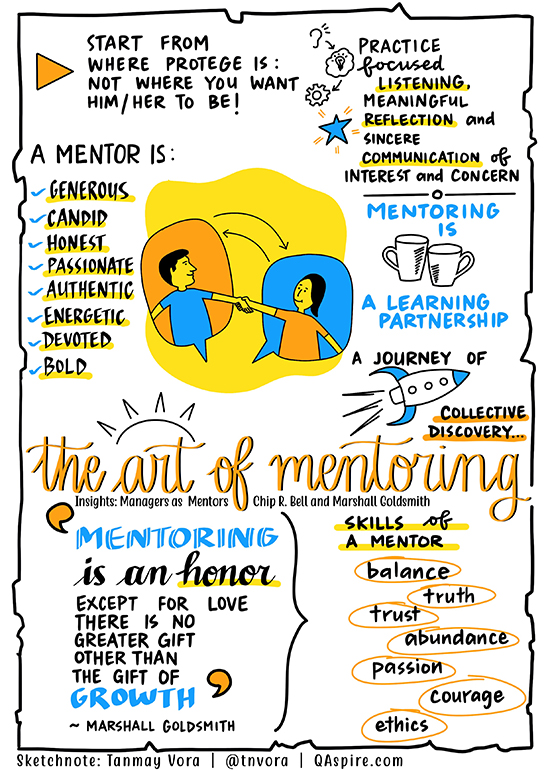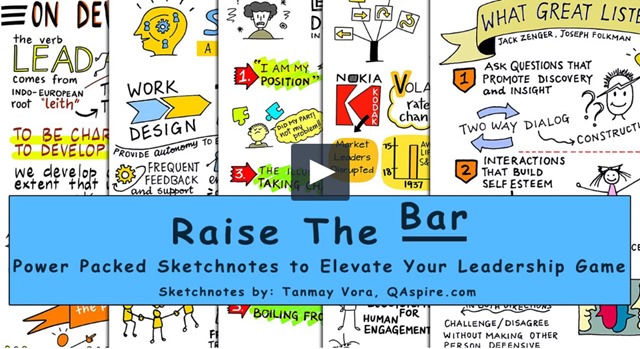Reprise: Interview with Sir Marshall Goldsmith and Chip Bell on Effective Mentoring
Mentoring is an honor. Except for love, there is no greater gift one can give another than the gift of growth.
Tanmay Vora
I had the wonderful privilege of interviewing Sir Marshall Goldsmith and Chip R. Bell in 2013 when they released their book Managers as Mentors. The ideas they shared in the book as well as in the interview with me have served as a constant reminder to me that leadership in its best form is a gift of growth for others. With a firm belief that great ideas need to be repeatedly shared, I am re-posting the 2013 interview along with a revised sketchnote summary.
[Tanmay Vora] Chip and Marshall, it is my pleasure interviewing you. Effective mentoring is a great way to elevate capabilities of people. How does one approach mentoring when working in a hyper-competitive business environment where speed and results take up precedence?
[Chip Bell and Marshall Goldsmith] The same way any leadership or coaching activity occurs…it comes down to priority. In today’s time’s up work world, mentors can be impatient thus rendering the mentoring. Mentoring means starting where the protégé is, not where the mentor wants him or her to be. Mentor and protégé must focus on the quality of the process not a rush to the outcome. Mentoring need not be a long leisurely dialogue away from the chaotic highs and lows of a busy enterprise. Few mentors or protégés have the luxury of time to have a conversation as if over a five-course meal in a fancy restaurant. But, there must be time for a rapport-building appetizer and a where-do-we-go-from-here dessert. There must be time for focused listening and meaningful reflection. And, there must be time for the sincere communication of interest and concern.
“Mentoring means starting where the protégé is, not where the mentor wants him or her to be.”
[Tanmay Vora] If I am a mentor, what is your #1 tip for finding my protégés. What is your #1 tip if I am looking for a mentor?
[Chip Bell and Marshall Goldsmith] For the mentor, start with people you directly influence and supervise. The old-fashioned view of mentoring as someone outside the leader’s chain of command it no longer relevant. Arie de Guies wrote in his book, “The Living Company” these words: Your ability to learn faster than your competition is your only competitive sustainable advantage.” Leaders create learning organizations. For the protégé, select a mentor who can help you be the best you can, not one you think can help you get a promotion.Remember, you can sometimes learn more from people who are different than from people who are “just like you.”
[Tanmay Vora] In your book, you offer SAGE model of great mentoring. Can you explain that a bit for benefit of the readers of this blog?
[Chip Bell and Marshall Goldsmith] The mentoring model found in this book is built around the belief that great mentoring requires four core competencies, each of which can be applied in many ways. These competencies form the sequential steps in the process of mentoring. All four have been selected for their ability to blend effectively. Not accidentally, the first letters of these four competencies (and steps) spell the word “SAGE”—a helpful mnemonic as well as a symbolic representation of the goal, the power-free facilitation of learning. They are: Surrendering—leveling the learning field; Accepting—creating a safe haven for risk taking; Gifting—the core contributions of the mentor, the main event; and Extending—nurturing protégé independence.
Mentoring is an honor. Except for love, there is no greater gift one can give another than the gift of growth. It is a rare privilege to help another learn, have the relevant wisdom to be useful to another, and partner with someone who can benefit from that wisdom. This book is crafted with a single goal: to help you exercise that honor and privilege in a manner that benefits you and all those you influence.
[Tanmay Vora] Not all managers possess the qualities required to become an effective mentor. What are these qualities?
[Chip Bell and Marshall Goldsmith]
Balance. Unlike a relationship based on power and control, a learning partnership is a balanced alliance, grounded in mutual interests, interdependence, and respect. Power-seeking mentors tend to mentor with credentials and sovereignty; partnership-driven mentors seek to mentor with authenticity and openness. In a balanced learning partnership, energy is given early in the relationship to role clarity and communication of expectations; there is a spirit of generosity and acceptance rather than a focus on rules and rights. Partners recognize their differences while respecting their common needs and objectives.
Truth. Countless books extol the benefits of clear and accurate communication. Partnership communication has one additional quality: It is clean, pure, characterized by the highest level of integrity and honesty. Truth-seekers work not only to ensure that their words are pure (the truth and nothing but the truth) but also to help others communicate with equal purity. When a mentor works hard to give feedback to a protégé in a way that is caringly frank and compassionately straightforward, it is in pursuit of clean communication. When a mentor implores the protégé for candid feedback, it is a plea for clean communication. The path of learning begins with the mentor’s genuineness and candor.
Trust. Trust begins with experience; experience begins with a leap of faith. Perfect monologues, even with airtight proof and solid support documentation, do not foster a climate of experimentation and risk taking. They foster passive acceptance, not personal investment. If protégés see their mentors taking risks, they will follow suit. A “trust-full” partnership is one in which error is accepted as a necessary step on the path from novice to master.
Abundance. Partnership-driven mentors exude generosity. There is a giver orientation that finds enchantment in sharing wisdom. As the “Father of Adult Learning,” Malcolm Knowles, says, “Great trainers [and mentors] love learning and are happiest when they are around its occurrence.”1 Such relationships are celebratory and affirming. As the mentor gives, the protégé reciprocates, and abundance begins to characterize the relationship. And there is never a possessive, credit-seeking dimension (“That’s MY protégé”).
Partnership-driven mentors exude generosity. There is a giver orientation that finds enchantment in sharing wisdom.
Passion. Great mentoring partnerships are filled with passion; they are guided by mentors with deep feelings and a willingness to communicate those feelings. Passionate mentors recognize that effective learning has a vitality about it that is not logical, not rational, and not orderly. Such mentors get carried away with the spirit of the partnership and their feelings about the process of learning. Some may exude emotion quietly, but their cause-driven energy is clearly present. In a nutshell, mentors not only love the learning process, they love what the protégé can become—and they passionately demonstrate that devotion.
Courage. Mentoring takes courage; learning takes courage. Great mentors are allies of courage; they cultivate a partnership of courageousness. They take risks with learning, showing boldness in their efforts, and elicit courage in protégés by the examples they set. The preamble to learning is risk, the willingness to take a shaky step without the security of perfection. The preamble to risk is courage.
Ethics. Effective mentors must be clean in their learner-dealings, not false, manipulative, or greedy. Competent mentors must be honest and congruent in their communications and actions. They must not steal their learners’ opportunities for struggle or moments of glory. Great mentors refrain from coveting their learners’ talents or falsifying their own. They must honor the learner just as they honor the process of mutual learning.
Partnerships are the expectancy of the best in our abilities, attitudes, and aspirations. In a learning partnership, the mentor is not only helping the protégé but also continually communicating a belief that he or she is a fan of the learner. Partnerships are far more than good synergy. Great partnerships go beyond “greater than” to a realm of unforeseen worth. And worth in a mentoring partnership is laced with the equity of balance, the clarity of truth, the security of trust, the affirmation of abundance, the energy of passion, the boldness of courage, and the grounding of ethics.
[Tanmay Vora] From an organizational perspective, is it important to have a culture of mentoring, starting from the top? How does it help?
[Chip Bell and Marshall Goldsmith] Today’s organization succeed if they are growth-oriented, excellence-focused and innovative. Growth is about change, so is learning; excellence is about a pursuit of betterment, so is learning and innovative is about unfreezing old ways to find new ways, so is learning. When the organization embeds learning as a part of its DNA, the expression of that core is growth, excellence and innovation. So, what do leaders do in a learning organization? They mentor!
When the organization embeds learning as a part of its DNA, the expression of that core is growth, excellence and innovation.
[Tanmay Vora] Your book is a treasure trove of meaningful advice on the art of effective mentoring. If you had to share one message from the book for aspiring mentors, what would that be?
[Chip Bell and Marshall Goldsmith] Be humble, be curious, be courageous and be willing to share what you know with others in a partnership-relationship.
[Tanmay Vora] Thank you for offering third and revised edition of “Managers as Mentors”. It was a pleasure interviewing you and I am sure, readers of this blog will find your ideas and your book, a very useful resource on developing people and bring the best out of them. Thanks again.
[Chip Bell and Marshall Goldsmith] Thank you for giving us the opportunity to share with your leaders a topic we are passionate about. Happy mentoring!

Updated: Visual Leadership Pack of 55+ HD Sketchnotes
If you liked the sketchnote summary above, check out the Visual Leadership Pack of HD Sketchnotes – a compilation of high-resolution compilation with 68+ powerful (and timeless) ideas to elevate your leadership and learning game.

Inspiring and true!